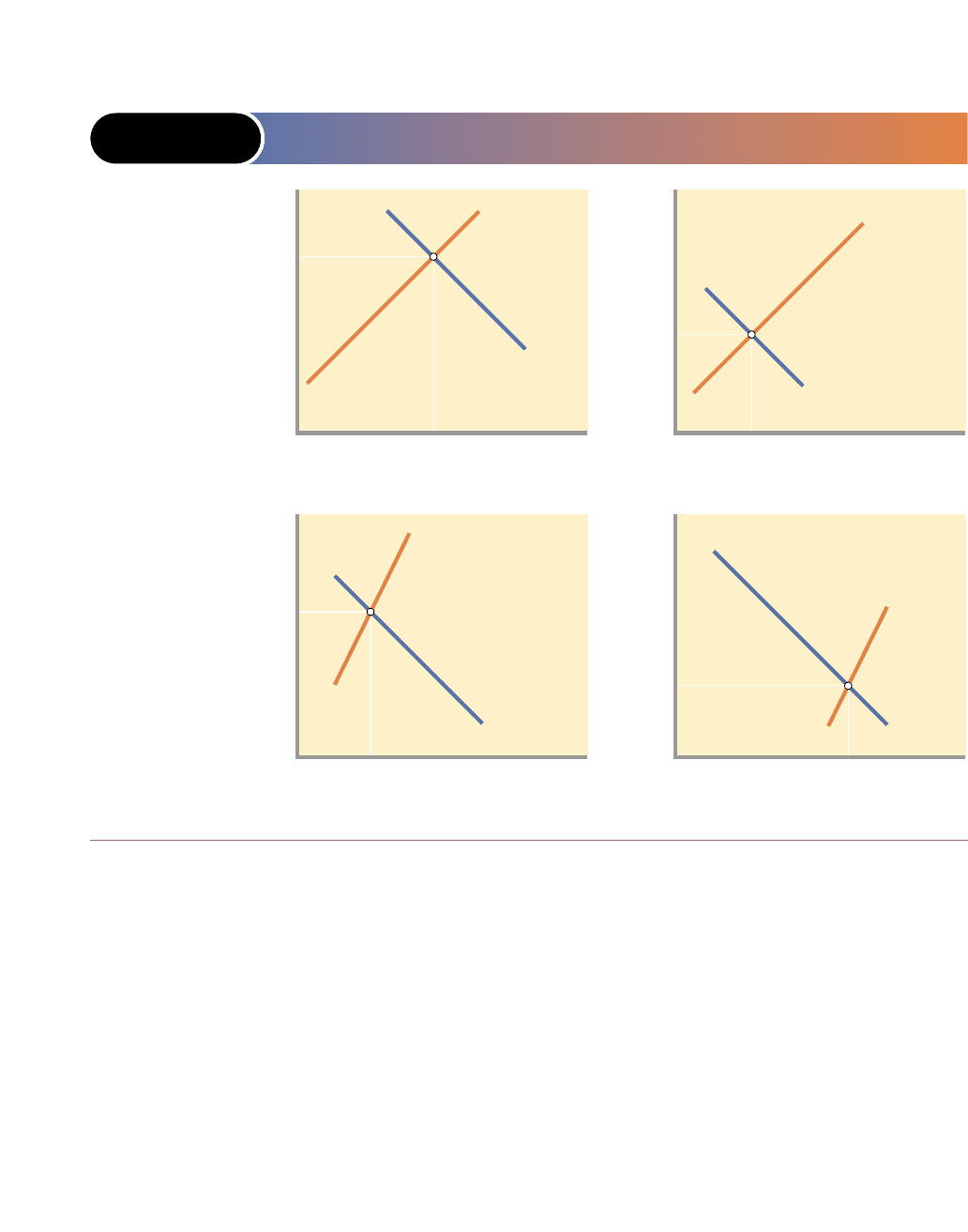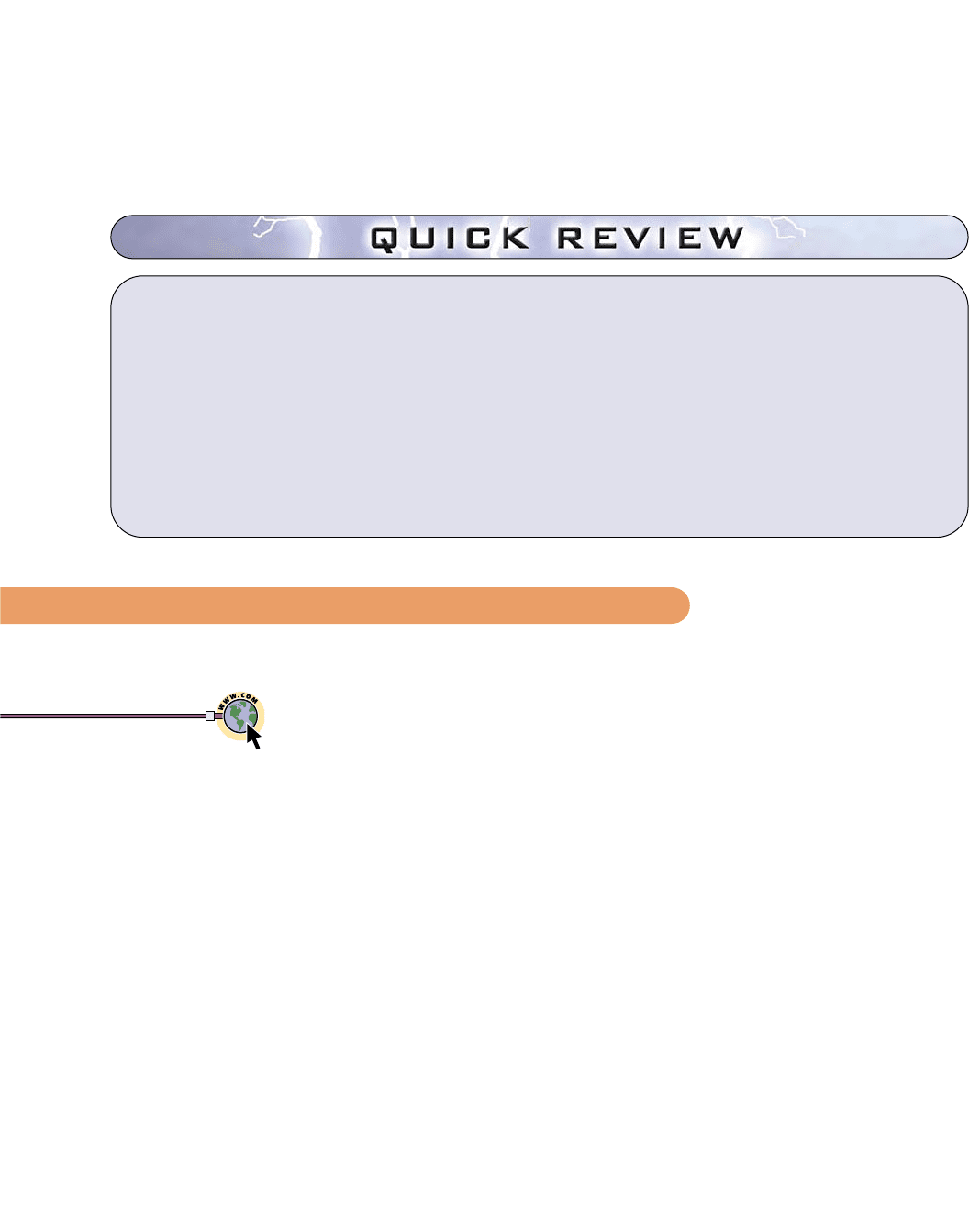McConnell Campbell R., Brue Stanley L., Barbiero Thomas P. Microeconomics. Ninth Edition
Подождите немного. Документ загружается.


Desirability of Bilateral Monopoly
The wage and employment outcomes in this situation might be more socially desir-
able than the term “bilateral monopoly” implies. The monopoly on one side of the
market might in effect cancel out the monopoly on the other side, yielding compet-
itive or near-competitive results. If either the union or management prevailed in this
market—that is, if the actual wage rate were determined at either W
u
or W
m
—
employment would be restricted to Q
m
(where MRP = MRC), which is below the
competitive level.
But now suppose the monopoly power of the union roughly offsets the monop-
sony power of management, and the union and management agree on wage rate W
c
,
which is the competitive wage. Once management accepts this wage rate, its incen-
tive to restrict employment disappears; no longer can it depress wage rates by
restricting employment. Instead, management hires at the most profitable resource
quantity, where the bargained wage rate W
c
(which is now the firm’s MRC) is equal
to the MRP. It hires Q
c
workers. Thus, with monopoly on both sides of the labour
market, the resulting wage rate and level of employment may be closer to compet-
itive levels than would be the case if monopoly existed on only one side of the mar-
ket. (Key Question 7)
In Canada both the federal and provincial governments have enacted minimum
wage legislation, but it is the provincial governments’ that cover most workers. The
provincial minimum wage ranges from $5.50 per hour in Newfoundland and Prince
Edward Island to $8.00 per hour in British Columbia. The purpose of the minimum
wage is to provide a living wage that will allow less-skilled workers to earn enough
for them and their children to escape poverty.
Case Against the Minimum Wage
Critics, reasoning in terms of Figure 15-7, contend that an above-equilibrium mini-
mum wage (say, W
u
) will simply push employers back up their labour demand
curves, causing them to hire fewer workers. The higher labour costs may even force
some firms out of business. Then, some of the poor, low-wage workers whom the
minimum wage was designed to help will find themselves out of work. Critics point
chapter fifteen • wage determination, discrimination, and immigration 391
The Minimum-Wage Controversy
● In the demand-enhancement union model, a
union increases the wage rate by increasing
labour demand through actions that increase
product demand, raise labour productivity, or
alter the prices of related inputs.
● In the exclusive (craft) union model, a union
increases wage rates by artificially restricting
labour supply, through, say, long apprentice-
ships or occupational licensing.
● In the inclusive (industrial) union model, a
union raises the wage rate by gaining control
over a firm’s labour supply and threatening to
withhold labour via a strike unless a negotiated
wage is obtained.
● Bilateral monopoly occurs in a labour market
where a monopsonist bargains with an inclu-
sive, or industrial, union. Wage and employ-
ment outcomes are determined by collective
bargaining in this situation.
minimum
wage
The lowest
wage employers
may legally pay for
an hour of work.
<info.load-otea.hrdc-
drhc.gc.ca/~legweb/
clc3/legislation/
l3tocen.htm>
Canada’s Labour Code

out that a worker who is unemployed at a minimum wage of $5.00 per hour is clearly
worse off than if employed at a market wage rate of, say, $4.50 per hour.
A second criticism of the minimum wage is that it is poorly targeted to reduce
poverty. Critics point out that much of the benefit of the minimum wage accrues to
teenage workers, most of whom receive only minimum wages for just a few years.
Case for the Minimum Wage
Advocates of the minimum wage say that critics analyze its impact in an unrealis-
tic context. Figure 15-7, advocates claim, assumes a competitive, static market. But
in a more realistic, low-pay labour market where there is some monopsony power
(Figure 15-8), the minimum wage can increase wage rates without causing unem-
ployment. Indeed, a higher minimum wage may even produce more jobs by elimi-
nating the motive that monopsonistic firms have for restricting employment. For
example, a minimum wage floor of Wc in Figure 15-8 would change the firm’s
labour supply curve to W
c
aS and prompt the firm to increase its employment from
Q
m
workers to Q
c
workers.
A minimum wage may increase labour productivity, shifting the labour demand
curve to the right and offsetting any reduced employment that the minimum wage
might cause. For example, the higher wage rate might prompt firms to find more
productive tasks for low-paid workers, thereby raising their productivity. Alterna-
tively, the minimum wage may reduce labour turnover (the rate at which workers
voluntarily quit). With fewer low-productive trainees, the average productivity of
the firm’s workers would rise. In either case, the higher labour productivity would
justify paying the higher minimum wage. So, the alleged negative employment
effects of the minimum wage might not occur.
Evidence and Conclusions
Which view is correct? Unfortunately, there is no clear answer. All economists agree
there is some minimum wage so high that it would severely reduce employment.
Consider $20 an hour, as an absurd example. But no current consensus exists on the
employment effects of the present level of the minimum wage. Evidence in the 1980s
suggested that minimum wage hikes reduced employment of minimum wage
workers, particularly teenagers (16- to 19-year-olds). The consensus then was that a
10 percent increase in the minimum wage would reduce teenage employment by
about 1 to 3 percent. But Canadian evidence suggests that the minimum wage hikes
in the 1990s produced even smaller, and perhaps zero, employment declines among
teenagers.
4
The overall effect of the minimum wage is thus uncertain. On the one hand, the
employment and unemployment effects of the minimum wage do not appear to be
a great as many critics fear. On the other hand, because a large part of its effect is
dissipated on nonpoverty families, the minimum wage is not as strong an anti-
poverty tool as many supporters contend.
It is clear, however, that the minimum wage has strong political support. Perhaps
this stems from two realities: (1) more workers are helped by the minimum wage
than are hurt and (2) the minimum wage gives society some assurance that employ-
ers are not taking undo advantage of vulnerable, low-skilled workers.
392 Part Three • Microeconomics of Resource Markets
4
Alan Krueger, “Teaching the Minimum Wage in Econ 101 in Light of the New Economics of the
Minimum Wage,” Journal of Economic Education (forthcoming).

Hourly wage rates and annual salaries differ greatly among occupations. In Table
15-3 we list average weekly wages for several industries to illustrate such occupational
wage differentials. For example, observe that construction workers on average earn
almost a third more than those workers in the health and service industry. Large wage
differentials also exist within some of the occupations listed (not shown). For example,
although average wages for retail salespersons are relatively low, some top salesper-
sons selling on commission make several times the average wages for their occupation.
What explains wage differentials such as these? Once again, the forces of demand and
supply are revealing. As we demonstrate in Figure 15-9, wage differentials can arise on
either the supply or demand side of labour markets. Figures 15-9(a) and (b) represent
labour markets for two occupational groups that have identical labour supply curves. The
labour market in panel a has a relatively high equilibrium wage (W
a
) because labour
demand is very strong. The labour market in panel b has an equilibrium wage that is rel-
atively low (W
b
) since labour demand is weak. Clearly, the wage differential between
occupations (a) and (b) results solely from differences in the magnitude of labour demand.
Contrast that situation with Figure 15-9(c) and (d), where the labour demand
curves are identical. In the labour market in panel (c), the equilibrium wage is rela-
tively high (W
c
) because labour supply is highly restricted. In the labour market in
panel (d) labour supply is highly abundant, so the equilibrium wage (W
d
) is rela-
tively low. The wage differential between (c) and (d) results solely from the differ-
ences in the magnitude of the labour supply.
Although Figure 15-9 provides a good starting point for understanding wage dif-
ferentials, we need to know why demand and supply conditions differ in various
labour markets.
Marginal Revenue Productivity
The strength of labour demand—how far rightward
the labour demand curve is located—differs greatly
among occupations because of differences in how
much various occupational groups contribute to
their employers’ revenue. This revenue contribution,
in turn, depends on the workers’ productivity and
the strength of the demand for the products they are
helping to produce. Where labour is highly produc-
tive and product demand is strong, labour demand
also is strong, and other things equal, pay is high.
Top professional athletes, for example, are highly
productive at sports entertainment, for which mil-
lions of people are willing to pay billions of dollars
over the course of a season. So the marginal revenue
productivity of these top players is exceptionally
high, as are their salaries, represented in Figure
15-9(a). In contrast, in most occupations workers
generate much more modest revenue for their
employers, so their pay is lower, as in Figure 15-9(b).
Noncompeting Groups
On the supply side of the labour market, workers
are not homogeneous; they differ in their mental
chapter fifteen • wage determination, discrimination, and immigration 393
Wage Differentials
wage differ-
entials
The
difference between
the wage received
by one worker or
group of workers
and that received by
another worker or
group of workers.
TABLE 15-3 AVERAGE
WEEKLY WAGES
IN SELECTED
INDUSTRIES, 2000
Average weekly
earnings
(including
Industry overtime)
All industries $ 626.45
Mining, quarrying, and oil wells 1,152.60
Logging and forestry 821.23
Transportation, storage,
communications, and other utilities 779.32
Manufacturing 778.30
Finance, insurance, and real estate 777.52
Construction 722.84
Educational and related services 672.88
Health and social services 542.25
Trade 476.48
Source: Statistics Canada, <www.statcan.ca/english/Pgdb>.
Visit www.mcgrawhill.ca/college/mcconnell9 for data update.
marginal
revenue
productivity
How much workers
contribute to their
employers’ revenue.

and physical capacities and in their education and training. At any given time the
labour force is made up of many noncompeting groups of workers, each repre-
senting several occupations for which the members of a particular group qualify. In
some groups qualified workers are relatively few, whereas in others they are highly
abundant. Workers in one group do not qualify for the occupations of other groups.
ABILITY
Only a few workers have the ability or physical attributes to be brain surgeons, con-
cert violinists, top fashion models, research scientists, or professional athletes.
Because the supply of these particular types of labour is very small in relation to
labour demand, their wages are high, as in Figure 15-9(c). The members of these and
similar groups do not compete with one another or with other skilled or semiskilled
workers. The violinist does not compete with the surgeon, nor does the surgeon
compete with the violinist or the fashion model.
The concept of noncompeting groups can be applied to various subgroups and
even to specific individuals in a particular group. An especially skilled violinist can
394 Part Three • Microeconomics of Resource Markets
FIGURE 15-9 LABOUR DEMAND, LABOUR SUPPLY, AND WAGE
DIFFERENTIALS
W
W
a
0
Q
a
Q
(a) Strong labour demand
W
W
b
0
Q
b
Q
(b) Weak labour demand
S
a
D
a
S
b
D
b
W
W
c
0
Q
c
Q
(c) Restricted labour supply
W
W
d
0
Q
d
Q
(d) Abundant labour supply
S
c
D
c
S
d
D
d
The wage differential
between labour
markets (a) and
(b) results solely from
differences in labour
demand. In labour
market (c) and
(d), differences in
labour supply cause
the wage differential.
non-
competing
groups
Collec-
tions of workers in
the economy who
do not compete
with each other
for employment
because the skill
and training of
the workers in one
group are substan-
tially different
from those in other
groups.

command a higher salary than colleagues who play the same instrument. A handful
of top corporate executives earn 10 to 20 times as much as the average chief execu-
tive officer. In each of these cases, the supply of top talent is highly limited, since less
talented colleagues are only imperfect substitutes.
EDUCATION AND TRAINING
Another source of wage differentials has to do with differing amounts of investment
in human capital. An investment in human capital is an expenditure on education
or training that improves the skills and, therefore, the productivity of workers. Like expen-
ditures on machinery and equipment, expenditures on education or training that
increase a worker’s productivity can be regarded as investments. In both cases, cur-
rent costs are incurred with the intention that will lead to a greater future flow of
earnings.
Although education yields higher incomes, it carries substantial costs. A college
or university education involves not only direct costs (tuition, fees, books) but indi-
rect or opportunity costs (forgone earnings) as well. Does the higher pay received
by better-educated workers compensate for these costs? The answer is yes. Rates of
return are estimated to be 10 to 13 percent for investments in secondary education
and 8 to 12 percent for investments in college and university education. One gener-
ally accepted estimate is that each year of schooling raises a worker’s wage by about
8 percent. Also, the pay gap between college and university graduates and high-
school graduates increased sharply between 1980 and 2000.
Compensating Differences
If the workers in a particular noncompeting group are equally capable of perform-
ing several different jobs, you might expect the wage rates to be identical for all
these jobs. Not so. A group of high-school graduates may be equally capable of
becoming sales clerks or construction workers, but these jobs pay different wages.
In virtually all locales, construction labourers receive much higher wages than sales
clerks. These wage differentials are called compensating differences, because they
must be paid to compensate for nonmonetary differences in various jobs.
The construction job involves dirty hands, a sore back, the hazard of accidents,
and irregular employment, both seasonally and cyclically. The retail sales job means
clean clothing, pleasant air-conditioned surroundings, and little fear of injury or lay-
off. Other things equal, it is easy to see why some workers would rather pick up a
credit card than a shovel. So labour supply is more limited for construction firms,
as in Figure 15-9(c), than for retail shops, as in Figure 15-9(d). Construction firms
must pay higher wages than retailers to compensate for the unattractive nonmone-
tary aspects of construction jobs.
Compensating differences play an important role in allocating society’s scarce
labour resources. If very few workers want to be garbage collectors, then society
must pay high wages to garbage collectors to get the garbage collected. If many
more people want to be sales clerks, then society need not pay them as much as
garbage collectors to get those services performed.
Market Imperfections
The ideas of marginal revenue productivity, noncompeting groups, and differences
in nonmonetary aspects of jobs explain many of the wage differentials in the econ-
omy. But other persistent differentials result from several types of market imperfec-
tions that impede workers from leaving their current jobs to take higher-paying jobs.
chapter fifteen • wage determination, discrimination, and immigration 395
investment
in human
capital
Any
expenditure under-
taken to improve
the education, skills,
health, or mobility
of workers, with
an expectation of
greater productivity
and thus a positive
return on the
investment.
compen-
sating
differences
Differences in the
wages received by
workers in different
jobs to compensate
for nonmonetary
differences in the
jobs.

LACK OF JOB INFORMATION
Workers may simply be unaware of job opportunities and wage rates in other
geographic areas and in other jobs for which they qualify. Consequently, the
flow of qualified labour from lower-paying to higher-paying jobs—and thus the
adjustments in labour supply—may not be sufficient to equalize wages within
occupations.
GEOGRAPHIC IMMOBILITY
Workers take root geographically. Many are reluctant to move to new places, to
leave friends, relatives, and associates, to force their children to change schools, to
sell their houses, or to incur the costs and inconveniences of adjusting to a new job
and a new community. As Adam Smith noted more than two centuries ago, “A [per-
son] is of all sorts of luggage the most difficult to be transported.” The reluctance or
inability of workers to move creates geographic wage differentials within the same
occupation to persist.
UNIONS AND GOVERNMENT RESTRAINTS
Wage differentials may be reinforced by artificial restrictions on mobility imposed by
unions and government. We have noted that craft unions find it to their advantage
to restrict membership. After all, if carpenters and bricklayers become too plentiful,
the wages they can command will decline. Thus, the low-paid nonunion carpenter
of Edmonton, Alberta, may be willing to move to Vancouver in the pursuit of higher
wages, but her chances for succeeding are slim. She may be unable to get a union
card, and no card means no job. Similarly, an optometrist or lawyer qualified to prac-
tise in one province may not meet licensing requirements of other provinces, so his
ability to move is limited. Other artificial barriers involve pension plans and senior-
ity rights that might be jeopardized by moving from one job to another.
DISCRIMINATION
Despite legislation to the contrary, discrimination sometimes results in lower wages
being paid to women and visible-minority workers than to white males doing vir-
tually identical work. Also, women and minorities may be crowded into certain
low-paying occupations, driving down wages there and raising them elsewhere.
If discrimination keeps qualified women and minorities from taking the higher-
paying jobs, then differences in pay will persist.
All four considerations—differences in marginal revenue productivity, noncom-
peting groups, nonmonetary differences, and market imperfections—come into
play in explaining actual wage differentials. For example, the differential between
the wages of a physician and those of a construction worker can be explained based
on marginal revenue productivity and noncompeting groups. Physicians generate
considerable revenue because of their high productivity and the strong willingness
of consumers (via provincial governments) to pay for health care. Physicians also
fall into a noncompeting group where, because of stringent training requirements,
only a relatively few persons qualify. So the supply of labour is small in relation
to demand.
In some construction work, where training requirements are much less signifi-
cant, the supply of labour is great relative to demand, so, wages are much lower for
construction workers than for physicians. However, if not for the unpleasantness of
the construction worker’s job and the fact that the craft union observes restrictive
membership policies, the differential would be even greater than it is.
396 Part Three • Microeconomics of Resource Markets

The models of wage determination we have described in this chapter assume that
worker pay is always a standard amount for each hour’s work, for example, $15 per
hour. But pay schemes are often more complex than that in both composition and
purpose. For instance, many workers receive annual salaries rather than hourly pay.
Many workers also receive fringe benefits: dental insurance, life insurance, paid
vacations, paid sick-leave days, pension contributions, and so on. Finally, some pay
plans are designed to elicit a desired level of performance from workers. This last
aspect of pay plans requires further elaboration.
The Principal–Agent Problem Revisited
In Chapter 3 we first identified the principal–agent problem as it relates to possible dif-
ferences in the interests of corporate stockholders (principals) and the executives
(agents) they hire. This problem extends to all workers. Firms hire workers because
they are needed to help produce the goods and services the firms sell for a profit.
Workers are the firms’ agents; they are hired to advance the interest (profit) of the
firms. The principals are the firms; they hire agents to advance their goals. Firms
and workers have one interest in common: they both want the firm to survive and
thrive. That will ensure profit for the firm and continued employment and wages for
the workers.
But the interests of the firm and of the workers are not identical. A principal–
agent problem arises when those interests diverge. Workers may seek to increase
their utility by shirking on the job, that is, by providing less than the agreed-on
effort or by taking unauthorized breaks. They may improve their well-being by
increasing their leisure, during paid work hours, without forfeiting income. The
night security guard in a warehouse may leave work early or spend time reading a
novel rather than making the assigned rounds. A salaried manager may spend time
away from the office visiting friends rather than attending to company business.
Firms (principals) have a profit incentive to reduce or eliminate shirking. One
option is to monitor workers, but monitoring is difficult and costly. Hiring another
worker to supervise or monitor the security guard might double the cost of main-
taining a secure warehouse. Another way of resolving the principal–agent problem
is through some sort of incentive pay plan that ties worker compensation more
closely to output or performance. Such incentive pay schemes include piece rates,
commissions and royalties, bonuses and profit sharing, and efficiency wages.
PIECE RATES
Piece rates consist of compensation paid according to the number of units of output
a worker produces. If a principal pays fruit pickers by the bushel or typists by the
page, it need not be concerned with shirking or with monitoring costs.
COMMISSIONS OR ROYALTIES
Unlike piece rates, commissions and royalties tie compensation to the value of sales.
Employees who sell products or services—including real estate agents, insurance
agents, stockbrokers, and retail salespersons—commonly receive commissions that
are computed as a percentage of the monetary value of their sales. Recording artists
and authors are paid royalties, computed as a certain percentage of sales revenues
from their works. Such types of compensation link the financial interests of the
salespeople or artists and authors to the profit interest of the firms.
chapter fifteen • wage determination, discrimination, and immigration 397
Pay for Performance
incentive
pay plan
A
compensation
structure that ties
worker pay directly
to performance
such as piece rates,
bonuses, stock
options, commis-
sions, and profit
sharing.

BONUSES, STOCK OPTIONS, AND PROFIT SHARING
Bonuses are payments in addition to one’s annual salary that are based on some fac-
tor such as the performance of the individual worker, or of a group of workers, or of
the firm itself. A professional baseball player may receive a bonus based on a high bat-
ting average, the number of home runs hit, or the number of runs batted in. A busi-
ness manager may receive a bonus based on the profitability of her or his unit. Stock
options allow workers to buy shares of their employer’s stock at a fixed, lower price
when the stock price rises. Such options are part of the compensation packages of top
corporate officials, as well as many workers in relatively new high technology firms.
Profit-sharing plans allocate a percentage of a firm’s profit to its employees. Such plans
have in recent years resulted in large annual payments to many Canadian workers.
EFFICIENCY WAGES
The rationale behind efficiency wages is that employers will enjoy greater effort from
their workers by paying them above-equilibrium wage rates. Glance back at Figure
15-3, which shows a competitive labour market in which the equilibrium wage rate
is $10. What if an employer decides to pay an above-equilibrium wage of $12 per
hour? Rather than putting the firm at a cost disadvantage compared with rival firms
paying only $10, the higher wage might improve worker effort and productivity so
that unit labour costs actually fall. For example, if each worker produces 10 units of
output per hour at the $12 wage rate compared with only 6 units at the $10 wage
rate, unit labour costs for the high-wage firm will be only $1.20 (= $12 ÷ 10) com-
pared to $1.67 (= $10 ÷ 6) for firms paying the equilibrium wage.
An above-equilibrium wage may enhance worker efficiency in several ways. It
enables the firm to attract higher-quality workers, it lifts worker morale, and it low-
ers turnover, resulting in a more experienced workforce, greater worker productiv-
ity, and lower recruitment and training costs. Because the opportunity cost of losing
a higher-wage job is greater, workers are more likely to put forth their best efforts
with less supervision and monitoring. In fact, efficiency wage payments have
proven effective for many employers.
Addenda: The Negative Side Effects of Pay for Performance
Although pay for performance may help to overcome the principal–agent problem
and enhance worker productivity, such plans may have negative side effects and so
require careful design. Here are a few examples:
● The rapid production pace that piece rates encourage may result in poor prod-
uct quality and may compromise the safety of workers. Such outcomes can be
costly to the firm over the long run.
● Commissions may cause some salespeople to engage in questionable or even
fraudulent sales practices, such as making exaggerated claims about products
or recommending unneeded repairs. Such practices may lead to private law-
suits or government legal action.
● Bonuses based on personal performance may disrupt the close cooperation
needed for maximum team production. A professional basketball player who
receives a bonus for points scored may be reluctant to pass the ball to teammates.
● Since profit sharing is usually tied to the performance of the entire firm, less
energetic workers can free-ride by obtaining their profit share based on the
hard work of others.
398 Part Three • Microeconomics of Resource Markets

● There may be a downside to the reduced turnover resulting from above-market
wages: Firms that pay efficiency wages have fewer opportunities to hire new
workers and suffer the loss of new blood that sometimes energizes the workplace.
Broadly defined, labour market discrimination occurs when equivalent labour
resources are paid or treated differently even though their productive contributions
are equal. These differences result from a combination of nondiscriminatory and
discriminatory factors. For example, studies indicate that about one-half the differ-
ences in earnings between men and women and between whites and visible minori-
ties can be explained by such nondiscriminatory factors as differences in education,
age, training, industry and occupation, union membership, location, work experi-
ence, continuity of work, and health. (Of course, some of these factors may be influ-
enced by discrimination.) The other half is an unexplained difference, the bulk of
which economists attribute to discrimination
In labour market discrimination, certain groups of people are often accorded infe-
rior treatment with respect to hiring, occupational access, education and training,
promotion, wage rates, or working conditions even though they have the same abil-
ities, education and training, and experience as the more preferred groups. People
who practise discrimination are said to exhibit a prejudice or bias against the targets
of their discrimination.
Types of Discrimination
Labour market discrimination may take several forms:
● Wage discrimination occurs when women or members of minorities are paid
less than white males for doing the same work. This kind of discrimination is
declining because of its explicitness and the fact that it clearly violates federal
law. But wage discrimination can be subtle and difficult to detect. For exam-
ple, women and minorities sometimes find that their job classifications carry
lower pay than job classifications held by white males, even though they are
performing essentially the same tasks.
chapter fifteen • wage determination, discrimination, and immigration 399
Labour Market Discrimination
<is.dal.ca/~eequity/
INFO/question.htm>
Frequently asked
employment equity
questions
● Proponents of the minimum wage argue that it
is needed to assist the working poor and to
counter monopsony where it might exist; critics
say that it is poorly targeted to reduce poverty
and that it reduces employment.
● Wage differentials are generally attributable to
the forces of supply and demand, influenced by
differences in workers’ marginal revenue pro-
ductivity, workers’ education and skills, and non-
monetary differences in jobs. Several labour
market imperfections also play a role.
● As it applies to labour, the principal–agent prob-
lem is one of workers pursuing their own inter-
ests to the detriment of the employer’s profit
objective.
● Pay-for-performance plans (piece rates, com-
missions, royalties, bonuses, profit sharing, and
efficiency wages) are designed to improve
worker productivity by overcoming the principal–
agent problem.
wage dis-
crimination
The payment of a
lower wage to
members of a less-
preferred group
than to members of
a more-preferred
group for the same
work.

● Employment discrimination takes place when women or visible-minority
workers receive inferior treatment in hiring, promotions, assignments, tem-
porary layoffs, and permanent discharges. This type of discrimination also
encompasses sexual and racial harassment—demeaning treatment in the
workplace by coworkers or administrators.
● Occupational discrimination occurs when women or visible-minority work-
ers are arbitrarily restricted or prohibited from entering the more desirable,
higher-paying occupations. Businesswomen have found it difficult to break
through the “glass ceiling” that prevents them from moving up to executive
ranks. Visible minorities in executive and sales positions are relatively rare. In
addition, skilled and unionized work such as electrical work, bricklaying, and
plumbing do not have high visible minority representation.
● Human capital discrimination occurs when women or members of minorities
do not have the same access to productivity-enhancing investments in education
and training as white males. For example, the lower average educational attain-
ment of visible minorities has reduced their opportunities in the labour market.
Costs of Discrimination
Discrimination imposes costs on those who are discriminated against. The groups
that discriminate get the good jobs and the better pay that are withheld from the tar-
gets of discrimination. But discrimination does more than simply transfer benefits
from women and visible minorities to men and whites; where it exists, discrimina-
tion actually diminishes the economy’s output and income; like any other artificial
barrier to free competition, it decreases economic efficiency and reduces production.
By arbitrarily blocking certain qualified groups of people from high-productivity
(and thus high-wage) jobs, discrimination prevents them from making their maxi-
mum contribution to society’s output, income, and well-being.
The effects of discrimination can be depicted as a point inside the economy’s pro-
duction possibilities curve, such as point D in Figure 15-10. At such a point, the econ-
omy obtains some combination of capital and consumption goods—here, K
d
+
C
d
—that is less desirable than combinations represented by points such as X, Y, or Z
on the curve. By preventing the economy from achieving productive efficiency, dis-
crimination reduces the nation’s real output and income. Very rough estimates suggest
that the Canadian economy would gain $32 billion per year by eliminating racial and
ethnic discrimination and some $18 billion per year by ending gender discrimination.
Prejudice reflects complex, multifaceted, and deeply ingrained beliefs and atti-
tudes. Thus, economics can contribute some insight into discrimination but no
detailed explanations. With this caution in mind, let’s look more deeply into the eco-
nomics of discrimination.
Taste-for-Discrimination Model
The taste-for-discrimination model examines prejudice by using the emotion-free
language of demand theory. It views discrimination as resulting from a preference
or taste for which the discriminator is willing to pay. The model assumes that, for
whatever reason, prejudiced people experience a subjective or psychic cost—a
400 Part Three • Microeconomics of Resource Markets
employment
discrimina-
tion
Inferior
treatment in hiring,
promotion, and
work assignment
for a particular
group of employees.
occupa-
tional dis-
crimination
Arbitrary restriction
of particular groups
from more desir-
able, higher-paying
occupations.
human
capital
discrimina-
tion
Arbitrary
restriction of par-
ticular groups
from productivity-
enhancing invest-
ments in education
and training.
Economic Analysis of Discrimination
taste-for-
discrimina-
tion model
A
theory of discrimi-
nation that views it
as a preference for
which an employer
is willing to pay.
